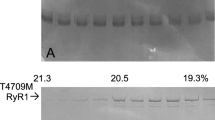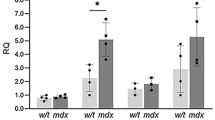Abstract
IT is thought that in skeletal muscle excitation–contraction (EC) coupling, the release of Ca2+ from the sarcoplasmic reticulum is controlled by the dihydropyridine (DHP) receptor in the transverse tubular membrane, where it serves as the voltage sensor1–3. We have shown previously4 that injection of an expression plasmid carrying the skeletal muscle DHP receptor complementary DNA3 restores EC coupling and L-type calcium current that are missing in skeletal muscle myotubes from mutant mice with muscular dysgenesis5–9. This restored coupling resembles normal skeletal muscle EC coupling4, which does not require entry of extracellular Ca2+ (refs 10, 11). By contrast, injection into dysgenic myotubes of an expression plasmid carrying the cardiac DHP receptor cDNA12 produces L-type calcium current and cardiac-type EC coupling13, which does require entry of extracellular Ca2+ (refs 14–16). To identify the regions responsible for this important functional difference between the two structurally similar DHP receptors, we have expressed various chimaeric DHP receptor cDNAs in dysgenic myotubes. The results obtained indicate that the putative cytoplasmic region between repeats II and III of the skeletal muscle DHP receptor3 is an important determinant of skeletal-type EC coupling.
This is a preview of subscription content, access via your institution
Access options
Subscribe to this journal
Receive 51 print issues and online access
$199.00 per year
only $3.90 per issue
Buy this article
- Purchase on Springer Link
- Instant access to full article PDF
Prices may be subject to local taxes which are calculated during checkout
Similar content being viewed by others
References
Schneider, M. F. & Chandler, W. K. Nature 242, 244–246 (1973).
Rios, E. & Brum, G. Nature 325, 717–720 (1987).
Tanabe, T. et al. Nature 328, 313–318 (1987).
Tanabe, T., Beam, K. G., Powell, J. A. & Numa, S. Nature 336, 134–139 (1988).
Gluecksohn-Waelsch, S. Science 142, 1269–1276 (1963).
Powell, J. A. & Fambrough, D. M. J. cell. Physiol. 82, 21–38 (1973).
Klaus, M. M., Scordilis, S. P., Rapalus, J. M., Briggs, R. T. & Powell, J. A. Devl Biol. 99, 152–166 (1983).
Beam, K. G., Knudson, C. M. & Powell, J. A. Nature 320, 168–170 (1986).
Rieger, F. et al. Nature 330, 563–566 (1987).
Armstrong, C. M., Bezanilla, F. M. & Horowicz, P. Biochim. biophys. Acta 267, 605–608 (1972).
Knudson, C. M., Jay, S. D. & Beam, K. G. Biophys. J. 49, 13a (1986).
Mikami, A. et al. Nature 340, 230–233 (1989).
Tanabe, T., Mikami, A., Numa, S. & Beam, K. G. Nature 344, 451–453 (1990).
Fabiato, A. J. gen. Physiol. 85, 291–320 (1985).
Beuckelmann, D. J. & Wier, W. G. J. Physiol., Lond. 405, 233–255 (1988).
Näbauer, M., Callewaert, G., Cleemann, L. & Morad, M. Science 244, 800–803 (1989).
Mishina, M. et al. Nature 307, 604–608 (1984).
Hamill, O. P., Marty, A., Neher, E., Sakmann, B. & Sigworth, F. J. Pflügers Arch. ges. Physiol. 391, 85–100 (1981).
Author information
Authors and Affiliations
Rights and permissions
About this article
Cite this article
Tanabe, T., Beam, K., Adams, B. et al. Regions of the skeletal muscle dihydropyridine receptor critical for excitation–contraction coupling. Nature 346, 567–569 (1990). https://doi.org/10.1038/346567a0
Received:
Accepted:
Published:
Issue Date:
DOI: https://doi.org/10.1038/346567a0
This article is cited by
-
Biophysical reviews top five: voltage-dependent charge movement in nerve and muscle
Biophysical Reviews (2023)
-
Regulatory mechanisms of ryanodine receptor/Ca2+ release channel revealed by recent advancements in structural studies
Journal of Muscle Research and Cell Motility (2021)
-
Excitation-contraction coupling in skeletal muscle: recent progress and unanswered questions
Biophysical Reviews (2020)
-
Blockade of microglial Cav1.2 Ca2+ channel exacerbates the symptoms in a Parkinson’s disease model
Scientific Reports (2019)
-
Voltage sensing mechanism in skeletal muscle excitation-contraction coupling: coming of age or midlife crisis?
Skeletal Muscle (2018)
Comments
By submitting a comment you agree to abide by our Terms and Community Guidelines. If you find something abusive or that does not comply with our terms or guidelines please flag it as inappropriate.



